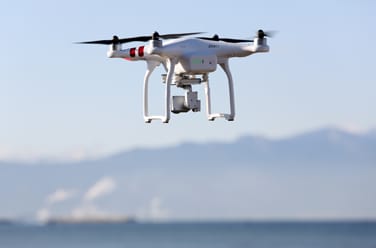Development of a drone that combines superior durability under harsh external conditions is on track!
Realizing professional drones with carbon fiber reinforced resin with low moisture absorption and excellent environmental resistance.
Industrial equipment manufacture Research and development *This article is an image story of problem solving using our products

The use of drones in high-altitude or exposed locations that would be too dangerous for human operators has become commonplace, as drones are deployed in ever more varied applications. In the US, for example, drones are now being used on beaches to protect swimmers from sharks.
Problem
We want to develop a drone that can handle surveys in harsh environments such as the ocean, mountains, and deserts...
Due to the growing variety of uses for which drones are applied, the developer and manufacturer of industrial drones featured in this case study was receiving a range of requests from drone users as well as its marketing partners. In recent years, there have been an increasing number of inquiries about drones that are expected to be used in external environments that are harsher than normal environments, such as observation surveys in the ocean and search for missing persons in mountains and desert areas.
An employee from the research and development team recalls:
“By using drones to survey maritime, mountain and desert areas, it is possible to not only reduce danger but also to search larger areas more efficiently. However, none of the drones in our range was suitable for these purposes”
The team would need to develop an entirely new type of drone that was distinct from the manufacturer’s existing models, which were used for aerial filming, factory inspections and similar purposes. The manufacturer decided to embark upon the development of such a drone, the R&D department has begun defining requirements for drones that can withstand harsh environments, such as moisture resistance against strong sea winds and weather resistance against bad weather.
“In the ocean, drones are exposed to strong sea breezes containing high humidity and salt content, and in mountainous and desert areas, strong ultraviolet rays, high temperatures, and sandy winds may continue to blow. To be used in drones suitable for such punishing conditions, materials need to have excellent humidity and climate resistance while also being lightweight and durable,” says the employee.
The polyamide (PA+CF) used in the manufacturer’s current drone models was very lightweight and had excellent impact resistance, giving it purposes in a wide range of industrial products. However, it was also highly hygroscopic, meaning that its dimensions and physical properties could change upon exposure to moisture. This material would not be able to ensure the performance required of a drone intended for use in punishing environments. To solve this problem, the team needed to first consider what materials offered the various physical properties required.
Summary of the Problem
- The amide resin (PA+CF) used in the manufacturer’s existing drone models was hygroscopic, so dimensions and physical properties tended to change upon exposure to moisture.
- The team needed a material that had excellent moisture and climate resistance while also being lightweight and durable.


